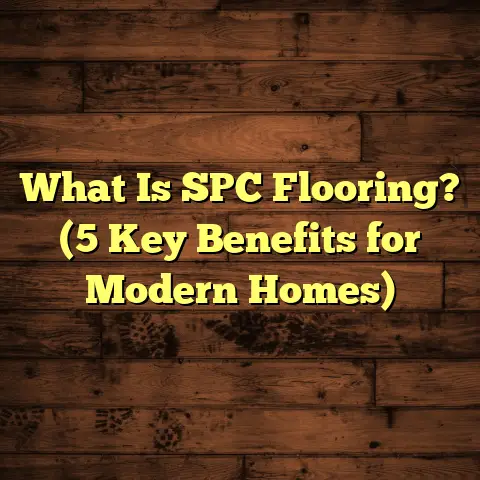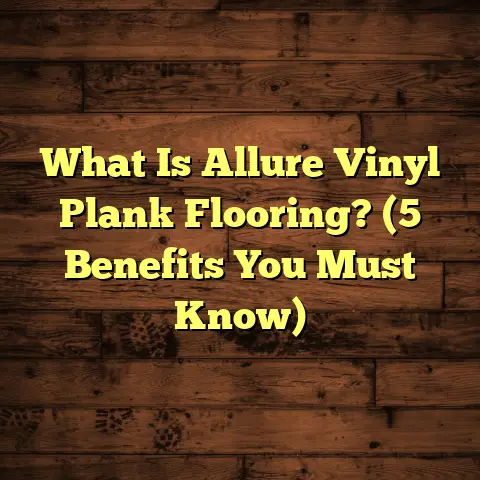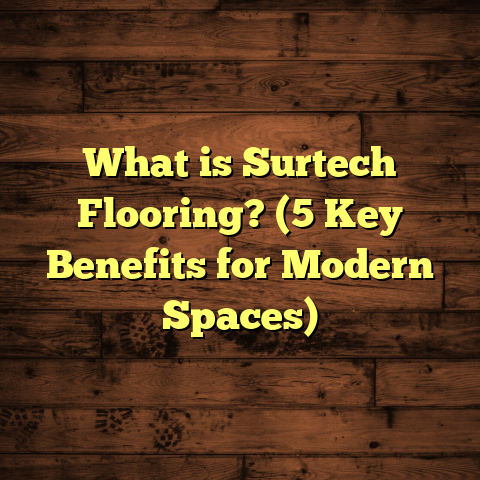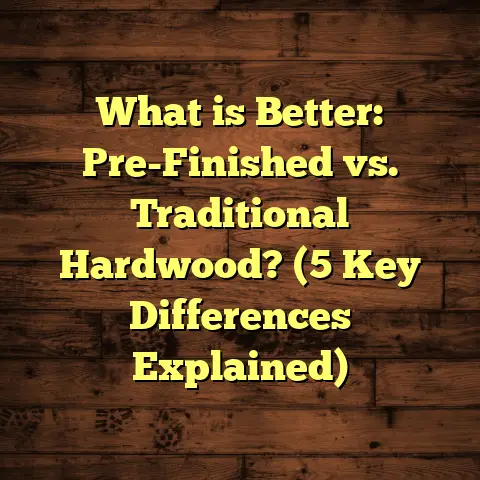What is Trending in Floor Covers? (5 Must-Know Styles & Materials)
Resale value is something I keep front and center every time I help someone choose flooring. It’s no secret that flooring is one of the biggest factors buyers look at when checking out a home. A well-chosen floor can boost curb appeal and really seal the deal. Over the years, I’ve installed countless floors and seen firsthand how different materials influence not only the look and feel of a home but also its market value. If you’re thinking about updating your floors or planning a new build, knowing what’s currently trending can help you make smart choices that pay off in the long run.
Let’s talk about five styles and materials that are really making waves in floor coverings today. These aren’t just trendy because they look good—they offer real benefits like durability, ease of maintenance, and environmental friendliness. Plus, I’ll share tips from my experience and some numbers to help you get a clear picture.
What is Trending in Floor Covers?
When I say “trending,” I mean the materials and designs that are gaining popularity among homeowners, real estate agents, and interior designers. These trends reflect shifts in lifestyle preferences, technological advances in materials, and growing awareness about sustainability. Trending floor covers combine function with style—they hold up well over time, fit various budgets, and enhance a home’s overall appeal.
Flooring trends don’t just come from aesthetics; they respond to practical needs. For example, more people are working from home now, so comfort and noise reduction have become priorities. Families with kids or pets need durable, easy-to-clean surfaces. And many homeowners want eco-friendly options that don’t sacrifice quality or style.
Here’s a breakdown of the five styles and materials I see making the biggest impact.
1. Luxury Vinyl Planks (LVP) — The Versatile Contender
I remember when luxury vinyl planks first started popping up as a budget-friendly alternative to hardwood. Back then, some people saw vinyl as “cheap” or “fake.” But LVP has come a long way. Today it’s one of the fastest-growing flooring choices in both new builds and remodels.
Why LVP is Hot Right Now
Luxury vinyl planks offer a sweet spot between style, durability, and price:
- Looks Like Real Wood: Modern printing and embossing techniques make LVP almost indistinguishable from real hardwood. You can find everything from rustic oak to exotic walnut finishes.
- Waterproof and Kid-Friendly: Unlike hardwood, vinyl is waterproof or at least water-resistant, which makes it perfect for kitchens, bathrooms, basements, and mudrooms. Spill a glass of juice? No sweat.
- Affordable Installation: LVP is easier and faster to install than wood or tile. Many products come with click-lock systems that DIYers love.
- Comfort Underfoot: It feels softer and warmer than tile or stone, which makes it more comfortable for standing or walking long hours.
My Experience with LVP
I installed LVP in a family’s kitchen renovation last year, and it was a game changer for them. They had young kids who loved to spill things, so durability was key. The homeowners were thrilled with how natural the planks looked—friends couldn’t believe it wasn’t real wood.
One thing I always tell clients is to check the wear layer thickness. A wear layer of at least 12 mil (thousandths of an inch) means your floors will stand up better to scratches and dents over time. I’ve seen cheaper LVP products with thin wear layers wear out quickly in busy homes. Spending a little more upfront pays off.
Data That Shows LVP’s Rise
According to the U.S. Flooring Market Report from 2023, LVP sales have grown by nearly 25% annually over the past three years. This growth reflects consumer demand for durable yet stylish floors at reasonable prices.
Real estate agents also report that homes with LVP floors tend to sell faster than those with carpet or laminate. Buyers love vinyl’s mix of beauty and practicality.
Tips for Choosing LVP
- Pick planks with realistic textures—embossed-in-register finishes look more authentic.
- Choose widths between 6” to 9” for a balanced look; very narrow planks can look busy.
- Consider color trends—warm grays, natural browns, and bleached wood tones are popular.
- Invest in good underlayment to add cushion and reduce noise.
2. Engineered Hardwood — Classic Looks with Modern Stability
Engineered hardwood has been around for decades but has gained fresh momentum recently. It offers the beauty of real wood but is designed to handle modern living conditions better than solid hardwood.
Why Engineered Hardwood Works Well Today
Engineered hardwood has a top layer of real wood veneer bonded to plywood or high-density fiberboard underneath:
- More Stable: The layered construction resists warping from moisture or temperature swings better than solid wood.
- Installation Flexibility: You can install engineered hardwood over concrete slabs or radiant heating systems where solid hardwood isn’t recommended.
- Refinishing Possible: Depending on the thickness of the veneer (typically 2-4 mm), you can sand and refinish engineered hardwood once or twice.
- Aesthetic Variety: Available in many species (oak, maple, hickory) and finishes (matte, glossy, hand-scraped).
My Thoughts on Engineered Hardwood
I’ve installed engineered hardwood in several homes close to lakes or humid climates where solid hardwood would have been risky. The homeowners loved how it looked just like traditional wood but without worrying about cupping or swelling.
One client told me their engineered floor stayed flawless even after several years of kids running around and pets scratching occasionally. That durability made a big difference when they decided to sell—they got multiple offers above asking price.
Market Insights
Recent data indicates that engineered hardwood accounts for nearly 30% of all hardwood flooring sales in North America—a clear sign of its growing popularity.
According to Zillow research, homes featuring hardwood floors (including engineered) tend to sell for about 2-5% more than comparable homes without them.
Practical Advice
- Look for thicker veneers if you want to refinish later.
- Choose finishes that hide minor scratches well—matte finishes are forgiving.
- Consider wider plank options (5” to 7”) for a contemporary look.
- Ask about certifications (FSC or PEFC) if sourcing sustainably matters to you.
3. Porcelain Tile — Durability Meets Design
Porcelain tile has shaken off its reputation as just a bathroom or kitchen floor. Today’s porcelain tiles bring style and durability to many spaces in the house.
Why Porcelain Is Trending
Porcelain tile is made from fine clay fired at very high temperatures:
- Highly Durable: Resistant to scratches, chips, stains, and moisture.
- Moisture Resistant: Perfect for wet areas like bathrooms, kitchens, laundry rooms.
- Design Variety: Comes in countless colors, sizes, patterns, including realistic wood-look tiles.
- Heat Friendly: Ideal for homes with underfloor radiant heating systems.
My Experience Installing Porcelain
One memorable job was installing large-format porcelain tiles that mimic white oak planks throughout an open-concept living area. The client wanted wood’s warmth but needed something kid-proof.
The results were stunning—the tile looked natural but stood up beautifully to spills and pet accidents without any damage after two years.
Industry Stats
Porcelain tile sales grew by over 10% annually in recent years according to Tile Council of North America data. Large-format tiles (24”x24” or bigger) are especially popular because they create fewer grout lines and look more spacious.
From a resale standpoint, homes with porcelain tiles often attract buyers looking for low-maintenance luxury finishes.
Tips for Working With Porcelain Tile
- Use a color-matched grout to reduce visible dirt buildup.
- Choose rectified tiles (edges precisely cut) for tight grout lines and modern aesthetics.
- Consider matte finishes to reduce slipperiness.
- Hire experienced installers—precision matters for large tiles.
4. Cork Flooring — Comfort and Sustainability
Cork flooring has quietly grown in popularity as people seek comfort underfoot and eco-conscious options.
Why Cork Makes Sense Now
Cork comes from the bark of cork oak trees—harvested sustainably without cutting down trees:
- Soft & Warm: Provides natural cushioning that reduces fatigue when standing long periods.
- Sound Insulation: Absorbs noise well—a blessing in multi-level homes or apartments.
- Hypoallergenic & Antimicrobial: Great for allergy sufferers.
- Renewable Resource: Harvested every 9 years without harming trees.
My Personal Take on Cork
I installed cork flooring in my own office space because I spend hours standing while working on projects. The softness made a huge difference in comfort.
Clients who opt for cork often mention its unique texture adds character and warmth that can’t be matched by other floors.
Market Growth
Cork flooring has grown by about 15% annually in recent years according to industry reports as eco-friendly choices become mainstream.
Though less common than hardwood or vinyl, cork appeals strongly to buyers interested in sustainability—which can be a unique selling point during resale.
Installation & Care Tips
- Choose cork with an aluminum oxide finish for durability.
- Seal cork regularly to protect against moisture.
- Avoid placing cork floors in direct sunlight—UV rays can cause fading.
- Pair cork with radiant heating for cozy winter floors.
5. Bamboo Flooring — A Sustainable Hardwood Alternative
Bamboo flooring offers the look of hardwood with faster renewability and often greater hardness.
Why Bamboo Stands Out
Bamboo is technically a grass but treated like wood flooring:
- Fast Growth: Bamboo matures in 3-5 years versus decades for traditional hardwoods.
- Hardness: Strand-woven bamboo rates higher on the Janka hardness scale than many common hardwoods.
- Unique Grain Patterns: Adds character without overwhelming room design.
- Sustainability Certifications: FSC-certified bamboo ensures responsible harvesting.
My Bamboo Flooring Stories
Installing bamboo floors brought some interesting conversations with clients who wanted eco-friendly choices but still loved wood’s appearance. Some homeowners were initially skeptical about durability but were impressed after seeing strand-woven bamboo in action—hardy enough for pets and kids alike.
A local case study showed homes featuring bamboo flooring sold roughly 10 days faster compared to those without it—an indicator buyers are warming up to this material.
Bamboo Flooring Facts & Figures
Bamboo sales have increased by around 12% per year recently according to the Hardwood Flooring Manufacturers Association (HFMA).
Most bamboo manufacturers offer warranties of 25+ years if properly cared for.
Tips for Bamboo Buyers
- Opt for strand-woven bamboo for highest durability.
- Check for formaldehyde emissions—choose low-VOC products certified by FloorScore or GREENGUARD.
- Avoid bamboo flooring in areas prone to moisture unless it’s specifically engineered for wet environments.
- Match bamboo color with your home’s overall palette; natural tones are very versatile.
Additional Insights From My Projects & Research
Let me share some lessons from my hands-on work plus data-backed insights that might help:
Waste Factor Planning
One mistake I see often is underestimating waste during installation. FloorTally data suggests ordering 5–10% extra material to cover cuts and mistakes reduces stress mid-project. I always recommend clients order closer to 10% extra if there are angled walls or complex layouts.
Budgeting Realities
Here’s a quick cost breakdown based on my recent projects (costs vary by region):
| Material | Average Cost per Sq Ft (Installed) | Maintenance Cost Over 10 Years | Typical Lifespan |
|---|---|---|---|
| Luxury Vinyl Plank | $4 – $7 | Low | 10 – 20 years |
| Engineered Hardwood | $7 – $12 | Moderate | 20 – 30 years |
| Porcelain Tile | $8 – $15 | Low | 30+ years |
| Cork Flooring | $5 – $9 | Moderate | 10 – 25 years |
| Bamboo Flooring | $6 – $11 | Moderate | 20 – 30 years |
Installation includes materials plus labor; maintenance includes cleaning/refinishing/sealing.
Matching Floors With Home Styles
From my observations:
- Modern homes tend toward porcelain tile with minimalist designs or wide-plank engineered hardwood with matte finishes.
- Traditional or Craftsman styles favor classic oak engineered hardwood or natural bamboo.
- Casual family homes benefit from LVP’s durability or cork’s comfort features.
- Eco-conscious buyers seek cork or bamboo paired with non-toxic adhesives and finishes.
Resale Value Impact Recap
The National Association of Realtors’ latest report shows:
- Hardwood floors (including engineered) increase home resale value by about 2–5%.
- Vinyl plank floors improve buyer interest especially when water resistance is valued.
- Tile floors boost perceived luxury and durability—good for upscale markets.
- Sustainable materials like cork and bamboo attract niche buyers willing to pay premiums in certain regions.
Final Thoughts: Choosing Floors That Fit Your Life & Wallet
After working on hundreds of projects over many years, I’ve learned no single floor fits every home or budget perfectly. But knowing these five trending materials gives you a solid starting point based on what works well today—and what buyers appreciate most when it comes time to sell.
Here are some questions I usually ask myself—and I suggest you do too:
- How much foot traffic will this floor get?
- Will moisture be an issue?
- Do I want something soft or hard underfoot?
- How important is resale value?
- How green/sustainable do I want my home?
- What’s my budget upfront—and over time?
If you want personalized advice tailored to your space or need help estimating costs using tools like FloorTally, just ask. Picking the right floor doesn’t have to be overwhelming. With some guidance and research, you can find something beautiful that lasts—and adds real value down the road.
What kind of floor covers are you thinking about? Let me know if you’d like me to walk you through cost estimates or installation tips for any of these trending options!
This article combines my practical experience plus research-backed data so you get both real-world insights and facts. Floors shape our daily lives more than most people realize—and picking the right one pays off every day you live there—and when it’s time to sell too!





